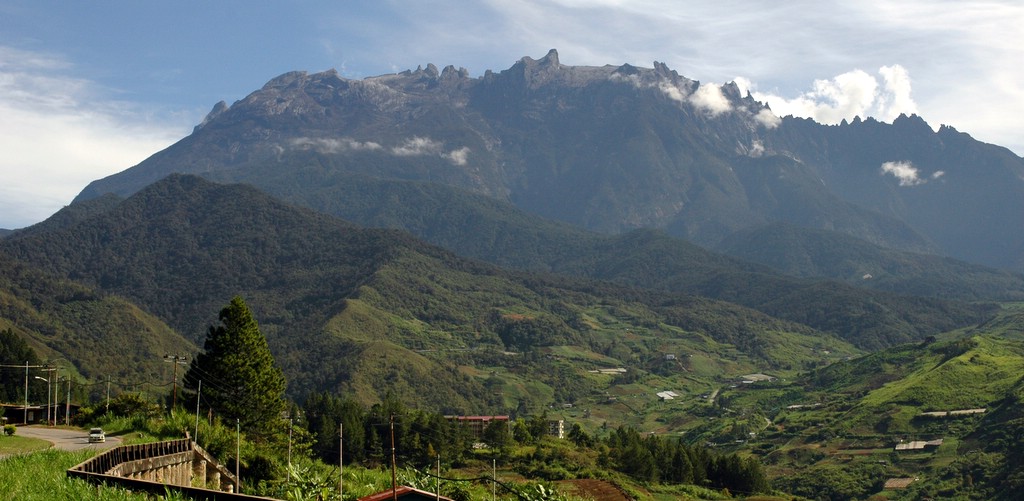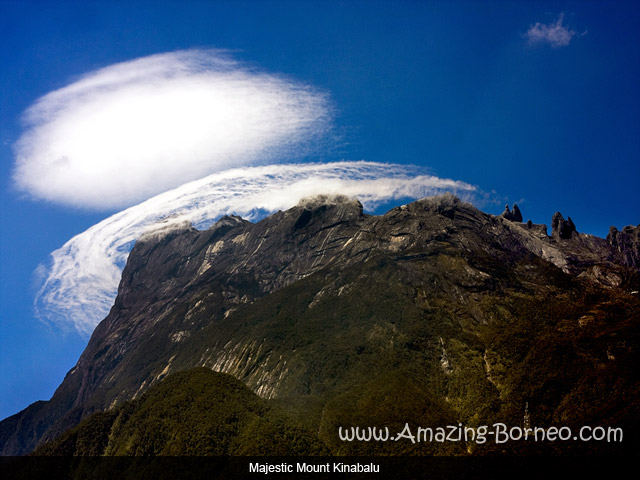I teetered
on the angled rock face of Mount Kinabalu, a rock face that seemed to go on
forever. If I ever slipped and fell, I knew I would keep tumbling down; there
was nothing to stop me. But oddly, I didn’t give a damn. Like a drunk, my mind
was a fog and all instincts for self-preservation seemed to have deserted me. I
was fifteen, on the climb with my high school friends, all of us struggling in
the altitude and numbing cold. I only wanted to make it to the top and didn’t
care if I died doing it.
Memories
of Mount Kinabalu returned to me in the comfort of my Canadian home in the
summer of 2015 when I read the news regarding foreigners stripping naked on its
peak – the prize of Mount Kinabalu National Park, a world heritage site. Who’d
want to do that? I thought about Sabah, the Malaysian state where Mount
Kinabalu is located, and its people who love this mountain. Was there another
mountain more loved than this one, I wondered. Somehow I doubted there was.
I
was born on Borneo Island and grew up with a clear line of sight of Mount
Kinabalu from my home in Kota Kinabalu. Our veranda was where I usually saw
our guests’ jaws drop open, floored by the panoramic view of Mount Kinabalu and
the surrounding landscape that included the Crocker Range and the South China
Sea. I always got a kick out of their reactions. My early artwork often
included the outline of Mount Kinabalu, along with a stick-ray drawing of the
sun. Everything I could see from my home became extensions of the walls around me,
my sense of security tied to it all.
When
I was eight, my parents, my brother and I, visited the Mount Kinabalu National
Park. It was 1972, and getting there entailed a day-long bone-shattering ride
on a dirt road. At lower elevation, the narrow interior road was full of
switchbacks that hung precipitously off the mountainside, but higher up the
road became a hair-raising roller coaster ride going up and down the rubbly
back of the mountain.
There
were no safety rails, and luckily we didn’t fall to the scary ravines and
valleys below. Meanwhile logging trucks terrorized us, thundering by at
breakneck speed in billowing clouds of dust. Nowadays, the same trip only takes
two hours by highway, a journey not nearly as thrilling.
Our
vehicle was a borrowed beat-up jeep from the survey department since my father
was a civil engineer. Instead of a proper roof it had a corrugated zinc sheet.
Each bump in the road caused the metal roof to clang over our heads.
Having
heard our cymbal-and-gong approach for miles, the Kadazan Dusun
natives living on the mountain hurried out to watch us pass by. Perhaps they
talked about us for days after; there couldn’t have been much excitement for
them living in huts and small farms up on the mountain where they grew
pineapples, tapioca, potatoes, and other rural crops. Weathered and hardy, they
scaled the mountain slopes barefooted, and carried loads on their backs in
woven baskets that were either strapped on their shoulders or around their
foreheads. It was hard to imagine these peaceful people were among the former
headhunters of Borneo.
If
as a child I’d become emotionally attached to Mount Kinabalu, imagine what it
meant to these natives who lived around it for millennia. They revered the
mountain, and believed it was the resting ground for the spirits of their
deceased. They believed an offering consisting of things like chicken, rice,
and betel nut, was crucial to ensure a safe climb. Or one might not return
alive. Now Christian and Muslim converts, they still retain their tradition by
performing a yearly ritual offering.
By
the time we arrived at the park we were covered from head to toe in orange
dust, looking more Caucasian than Chinese! Being in the tropics, it was a
novelty to see out our breath condensing in the chilly air. While our parents
registered, my brother and I went to a lookout point at the parking lot.
I
stared into another world. The Mount Kinabalu National Park, a huge reserve of
lush wilderness about the size of Singapore, seemed like a mysterious world
shrouded in shifting clouds, the faint call of wild birds occasionally emerging
from it.
The peak of Mount Kinabalu reached for the sky, but a swirling vortex
of clouds hid it and we had no clue it was right in front of us.
The
next morning, the clouds cleared and we found ourselves staring at the massive
granite peak, a sky-ward facing
monster, baring a mouth full of jagged teeth. Nothing could grow up there because
of the freezing temperature and lack of soil on the bare rocks, my mother
explained. At Mount
Kinabalu’s foot in the distance below us, the tightly packed rain forest formed an
unbroken cauliflower surface in shades of green, brown, and red.
We
discovered the summit trail, but to my disappointment my parents refused to go.
Instead we walked trails through rain forest with towering hardwood trees. I
scanned the forest floor for the rare Rafflesia, the largest single flower in
the world, big as a car tire and a stunning bright red with white spots. I
sniffed hard for its carrion smell, but had no luck.
We
gawked when we came across carnivorous pitcher plants with mug-sized traps,
ferns as tall as coconut trees, and unusual wild orchids. My brother and I
played with a giant millipede, the first we’d ever seen, until it coil up into
a tea-coaster-sized circle. We also had fun with a giant pill millipede, the
only one we ever saw, and marveled when it rolled up to the size of a golf
ball. It was as if we’d wandered into prehistoric times with gigantic insects and
plants, so different from where we lived by the coast, and I felt proud that
Mount Kinabalu supported such amazing nature.
I
eventually climbed Mount Kinabalu with my high school friends in 1979. The
first leg started in the morning from the park office and ended at 4pm at the
mid-way destination. The vegetation changed with elevation as we passed through
a few climatic zones, so that at first we saw tall tropical trees and towards
the end we encountered dwarf alpine plants. Unfortunately, our guide had given
us poor advice not to drink too much. I arrived dehydrated, exhausted, and too
sick to keep down any food.
Our
zinc shack crackled under the biting wind, and was cold as an iceberg. My
classmate shared her sleeping bag with me. Somehow, we squeezed our bodies into
the one-person mummy bag without bursting it.
Gazing out the window, I wondered
what that strange disc of light was, moving behind the mountain. Addled from the
shortage of oxygen, it took me half an hour to discern it was the moon and not
a UFO.
At
2 a.m., our native guide led us to the top. Hiking in the tunnel vision of my
flashlight, I was struck by the stillness. Nothing moved or made sounds on the
mountain except us. I heard myself gasping the thin air. I’d never been so cold or so tired; every few steps up the
sheer mountain required me to stop and rest. Using
all my will, I moved my log-heavy limbs and crawled to the 4,095-metre summit
where we awaited sunrise.
When
the first sun rays lit the rocks in a crown around us, I could’ve cried. I’d
done it. Savouring this fixture in my life up-close and enjoying the top-of-the-world
view it provided, I felt more connected than ever to the land of
my birth. In body I was half-dead, yet in spirit I was soaring.
Snapping
out of my memories back in my home in the western hemisphere, I shook my head
over the controversy surrounding the Mount Kinabalu nudists. Did they cause the
earthquake that happened days after they posed naked? The natives believe the
mountain’s spirit was angered and many locals blamed the visitors for the quake
which stranded over a hundred and fifty climbers and killed eighteen, including
a few native mountain guides.
The
local outcry was revealing of the deep emotions Sabahans have towards their
mountain, and I paused to examine my own. I didn’t share the same beliefs or
cast any blame, but I did feel Mount Kinabalu should be respected.
More
than just a mountain, it unites Sabahans and is a symbol of where I come from. It
conjures in my mind the scenic landscape of Sabah, the many faces of the multicultural
groups and their values, and the rich fauna and flora with endemic species only
to be found there. It is a beacon I search for whenever I visit this part of
the world, my stay incomplete until I have caught sight of it.
Considering
the furor they caused these nude visitors got away easily. At the same time I
hope they didn’t only bring home the memory of their consequent troubles, but
also plenty of this mountain’s wonder.
Adrienne Zoe was born in the Sabah, a state of Malaysia on the Island of Borneo, but
is now a resident of Waterloo, Ontario. She is currently writing a
memoir of what is was like growing up in Borneo, and maintains a Facebook
writer’s page here. A mother of two, she is a fine art photographer
and an avid tennis player. She is one of the artists of Uptown Gallery of
Waterloo, and her artist information can be found at her website here,
on her public Facebook page here,
and the gallery website here.
See Brian Henry’s schedule here, including writing workshops and creative writing courses in Algonquin Park, Alton, Barrie, Bracebridge, Brampton, Burlington, Caledon, Collingwood, Georgetown, Guelph, Hamilton, Ingersoll, Kingston, Kitchener, London, Midland, Mississauga, Newmarket, Orillia, Oakville, Ottawa, Peterborough, St. Catharines, Saint John, NB, Sudbury, Thessalon, Toronto, Windsor, Halton, Kitchener-Waterloo, Muskoka, Peel, Simcoe, York, the GTA, Ontario and beyond.





Thank you Brian for posting, and thanks to the Intensive Creative Writing classmates who helped edit this for publishing. You know who you are and you rock!
ReplyDeleteGod bless you.
ReplyDelete